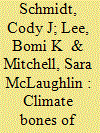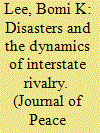| Srl | Item |
| 1 |
ID:
178651


|
|
|
|
|
| Summary/Abstract |
Many scholars examine the relationship between climate variability and intrastate conflict onset. While empirical findings in this literature are mixed, we know less about how climate changes increase the risks for conflicts between countries. This article studies climate variability using the issue approach to world politics. We examine whether climate variability influences the onset and militarization of interstate diplomatic conflicts and whether these effects are similar across issues that involve sovereignty claims for land (territory) or water (maritime, river). We focus on two theoretical mechanisms: scarcity (abundance) and uncertainty. We measure these concepts empirically through climate deviation (e.g. droughts/floods, heat waves/cold spells) and climate volatility (greater short-term variance in precipitation/temperature). Analyses of issue claims in the Western Hemisphere and Europe (1901–2001) show that greater deviations and volatility in climate conditions increase risks for new diplomatic conflicts and militarization of ongoing issues and that climate change acts as a trigger for revisionist states.
|
|
|
|
|
|
|
|
|
|
|
|
|
|
|
|
| 2 |
ID:
184188


|
|
|
|
|
| Summary/Abstract |
This article examines how disasters influence conflict dynamics in interstate rivalries. Building on insights from the disaster, rivalry, and diversionary conflict literatures, the authors argue that disasters act as political shocks that disrupt a rivalry relationship. Hostility levels in rivalries are stable over time and shift only through major shocks. While the rivalry literature suggests that some shocks may lead to peace, the authors argue that disaster shocks are more likely to be associated with increased conflict. Disasters often strain the state’s capacity to provide security for its people, while leaders who fail to prepare or respond can face domestic costs. To avoid potential removal from office, leaders have incentives to divert the public’s attention away from poor disaster response by adopting a more aggressive foreign policy. The authors hypothesize that the time between militarized disputes is shortened when pairs of states experience rapid onset disasters. However, the conditions for diversionary conflict depend on the degree of intrastate turmoil and the number of interstate rivalries, with disaster diversionary conflict happening most frequently in rivalry dyads with significant internal strife and multiple rivalries. Duration model analyses from 1900 to 2010 provide strong support for the theory and highlight the limits of disaster diplomacy in rivalry contexts. Given the increased frequency and severity of disasters globally, the findings suggest that environmental shocks are likely to increase interstate hostilities in conflict-prone regions.
|
|
|
|
|
|
|
|
|
|
|
|
|
|
|
|